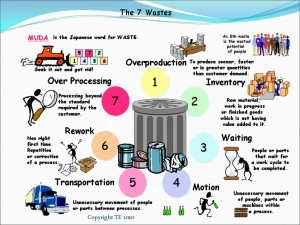 Tim Wood, a middle aged civil servant sits at a metal 1963 vintage Steelcase desk. A pile of forms stuff an inbox in the upper left portion of his desk. There is not a computer in sight. In a deliberate manner, Tim Wood removes a form from the inbox, reviews it, marks it with an X in the appropriate approval box, signs it, gets up, meanders through a set of office cubicles to the elevator, where he goes two floors up, wanders through another set of cubicles to another 1963 Steelcase desk, where he deposits the form in someone else’s inbox. He heads back down to his own desk and starts the process anew.
Tim Wood, a middle aged civil servant sits at a metal 1963 vintage Steelcase desk. A pile of forms stuff an inbox in the upper left portion of his desk. There is not a computer in sight. In a deliberate manner, Tim Wood removes a form from the inbox, reviews it, marks it with an X in the appropriate approval box, signs it, gets up, meanders through a set of office cubicles to the elevator, where he goes two floors up, wanders through another set of cubicles to another 1963 Steelcase desk, where he deposits the form in someone else’s inbox. He heads back down to his own desk and starts the process anew.
I often think that this is how the general public views those of us in the social services. We are Tim Woods, slow, meandering bureaucrats, doing nothing but wasting tax payer money on endless, needless paperwork.
Waste. In the quality world, waste is an enemy and waste is the purview of Lean.
Skinny is in and the hip kids are all creating Lean Start-ups, full of Lean thinking and Lean events designed to create and institute Lean processes with good flow. Our social servant Tim Wood with his full inbox is not a hip kid. He is not Lean. Tim Wood is the enemy.
Tim Wood is also a mnemonic device to help Lean learners remember the key sources of waste in a process. Lean comes from the manufacturing world (thanks Toyota) and it requires some translation for the service world and even more for the social service world, where profit is not the ultimate arbiter of success. This blog post takes a look at waste in the social services, using the Tim Wood classification system.
But first, we need to talk about what is waste and what is not. What is not waste is called value added activity. Value added activities are what the client is willing to pay for. In the manufacturing world, clients will pay for products that work. In the service world, they pay for service that helps. Anything we do that is true client service is value added. Some activities are non-value added, but required, by an insurer, regulator, or accreditor. This can be called several things, required non-value added or necessary non-value added or business non value added. The rest, what is non-value added and not required, is waste. And Lean practitioners talk about seven categories of waste.
T- Transportation. Tim carried his approved form from his cubicle to another cubicle on another floor upstairs. That is waste. A social service agency pays to transport by cab kids in foster care to skills classes. That is waste. An elder abuse investigator travels from the office to an apartment where an older person may be at risk. That is waste. As a foster care worker, I spent a lot of time in my car driving around the county. I’ll venture that transportation is a key source of waste in social service processes.
I- Inventory. In the manufacturing world, inventory is waste because you have to store it and storage costs money. Social service agencies may have less inventory waste than other sectors, but there might be some. Does the food pantry have too many cans of green beans? Does the child protection agency have too many car seats sitting in storage? My guess is that inventory is not a large source of waste in the social services.
M- Movement. Movement is not transportation. Think ergonomics, the movements you make at your work station to conduct business. How efficient is it? How much waste is there.?
W-Waiting. In a manufacturing setting, waiting is the time wasted waiting for the next product to move down the line so you can add your bolt to the widget or time wasted while the production line is down. As a foster care worker, I spent quite a bit of time waiting. I took kids to appointments and waited. I waited for parents who did not show up for visits with their kids.
O- Overproduction. It is hard for me to come up with examples of overproduction in the social services, because we do not typically produce goods. If I built a service and hired workers for which there was little demand, I might be guilty of over-estimating, but the waste would likely be in waiting.
O-Overprocessing. Overprocessing can take many forms. A classic example would be a form that requires several approval signatures. A work committee that writes an elaborate annual report instead of a tight one-page memo with bullet points might be another. Time is wasted and little value is added.
D- Defects. This is another category that is clear in manufacturing and muddled in the social services. A product with defects has to be scrapped or reworked. Defective social services may not yield the desired outcome. Service may be offered for a longer time or a client may use the service again and again (think detox and substance abuse treatment) because the service was not effective the first time. If ineffective, poorly delivered service is considered a defect, then this may be the biggest source of social service waste.O-Overprocessing.
Here are some lean questions for social service programs. What are your key value added activities (investigation, therapy, education, etc.)? These are likely the services someone is paying for (clients, grant funders, a government contract).
What are the key processes involved in this work? ( a trained facilitator can help you map out these processes?)
Do you sense that these key processes are full of waste? Think about waiting, overprocessing, transportation, and defective (ineffective) service as potential sources of waste that could be eliminated.
If you think your organization or team is plagued with waste, there are improvement processes and activities you and your teams can participate in to help reduce waste. Maybe your organization has a trained process improvement facilitator. If not, you can hire a freelance expert. Check out their training in Lean. Schedule a rapid improvement event.
Skinny is in, people. Think Lean.

Pingback: Toyota Kaizens the Food Bank | Quality Social Service